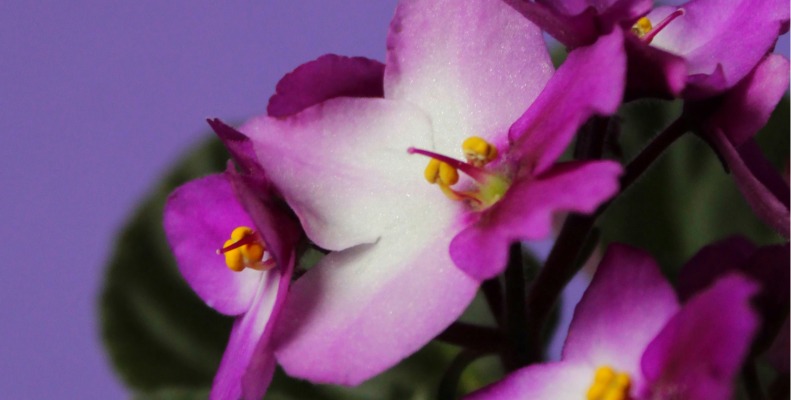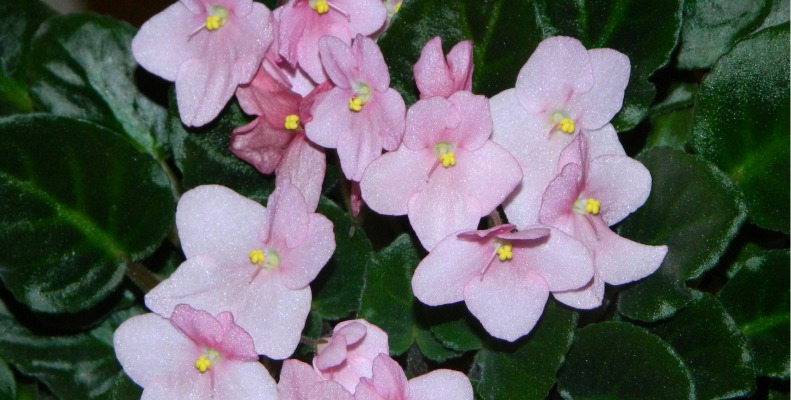African violets are very popular houseplants. They have thick, fuzzy leaves and flowers that look like violets. These flowers grow above the green leaves. You can find them in many different leaf shapes and colors. There are also single and double flowers, with frilled and other unique shapes. African violets can have one crown or multiple crowns and can also trail.
African violets add beauty to indoor spaces with their delicate flowers and lush leaves. It doesn’t matter if you’re an expert or just starting out, learning how to care for African violets is important. This includes knowing how much to water them, what soil they like best, how much light they need, and how to solve blooming issues. This guide covers everything you need to become an expert on these lovely plants.
Key Takeaways
- African violets are easy-to-care-for houseplants that can thrive in many indoor environments.
- Understanding the African Violet plant care requirements, such as lighting, watering, and soil, is essential for healthy growth and abundant blooms.
- Properly addressing African Violet blooming problems and mastering propagation techniques can help you maintain a vibrant, long-lasting African violet collection.
- Implementing pest control and disease management strategies is crucial for the overall well-being of your African violets.
- With the right care and attention, African violets can provide years of enjoyment and a beautiful addition to any indoor space.
African Violet Plant Care
Getting the right care for your African violets is essential. This ensures they grow well and bloom a lot. Now, we’ll look at what they need.
Lighting Requirements
African violets love bright, indirect light. They also do well with fluorescent lights. Just keep the lights about 12 to 15 inches from the leaves. For good growth and flowers, they need at least 6 hours of good light every day.
Temperature and Humidity Needs
These plants like it warm, but not too hot, between 70-90°F. They also need the air to be a bit humid, around 40-60%. Cold drafts and dry air are bad for them. If the temperature and humidity are right, they will flourish.
Soil and Potting Mix
African violets must have a potting mix that drains well. Look for mixes with peat moss, vermiculite, and perlite. This avoids waterlogging, which causes root rot. Heavy soils are a no-go for these plants.
| Lighting | Temperature | Humidity | Soil |
|---|---|---|---|
| Bright, indirect sunlight or fluorescent lights 12-15 inches above leaves | 70-90°F | 40-60% | Well-draining, porous potting mix with peat moss, vermiculite, and perlite |
Watering African Violet plant
It is vital to give African violets the right amount of water. They like to be kept slightly moist. But, don’t let them dry out completely or get too wet.
Signs of Underwatering and Overwatering
African violets will wilt and their leaves will feel soft if they don’t get enough water. This often starts at the bottom. Too much water, however, causes different problems. It can lead to root and stem rot, bringing diseases to the plant.
Watering Techniques
Water your violets when the top soil feels slightly dry. Avoid letting the soil completely dry out. This stresses the plant. Always use lukewarm, distilled, or purified water. Water the soil directly to keep the leaves and flowers dry.
Pay attention to how well your violet’s pot drains. Make sure the pot has holes in the bottom for water to escape. Always remove any water that sits in the saucer under the pot. Good drainage will keep the plant’s roots healthy.
| Watering Indicators | Underwatering | Overwatering |
|---|---|---|
| Leaf Appearance | Wilting, drooping, soft leaves | Yellowing, mushy, or rotting leaves |
| Soil Condition | Completely dry | Waterlogged, soggy |
| Root Health | Shriveled, brown roots | Mushy, discolored roots |
| Overall Plant Health | Stunted growth, lack of blooms | Root rot, stem rot, fungal diseases |
Fertilizing and Feeding
African violets love to eat, so they need good food often, mostly in spring and summer. Picking the right fertilizer and sticking to a feeding plan is key for their happiness.
Choosing the Right Fertilizer
For African violets, get a water-soluble fertilizer designed just for them. Aim for a 20-20-20 or 14-12-14 NPK mix. This combo feeds their leaves, helps flowers look bright, and roots grow strong.
Fertilization Schedule
In the spring and summer, feed them every two to four weeks with diluted fertilizer. Always use it as the label says to prevent leaf burn. Too much food isn’t good for them.
When autumn and winter come, slow down to feeding once a month or every six weeks. This lets the plants rest and get ready for growing again later.
| Fertilizer Type | Fertilization Frequency | Application Rate |
|---|---|---|
| African Violet-Specific Fertilizer | Every 2-4 weeks during spring and summer Every 6 weeks during fall and winter |
Follow product instructions for recommended dilution and application |
Taking good care by feeding African violets right means you’ll see them full of life, with beautiful flowers all year round.
Blooming and Flowering
African violets are famous for their near-constant blooming, if they’re well cared for. They need at least 6 hours of bright, but not direct, light every day for flowers.
Encouraging Blooms
To make your African violet flower a lot, put it where it can get plenty of indirect sunlight. You can also use fluorescent lights that are 12 to 15 inches away from the plant. Keep the room warm, between 70-90°F, and humid, ideally 40-60%, for the best results.
Common Blooming Problems
If your African violet isn’t blooming well, it might not be getting enough light. This, or big changes in temperature, too much water, or not the right fertilizers, can stop the flowers. By sorting these out, your violet should start blooming more often.
Propagation and Repotting
African violets are simple to grow from leaf cuttings or offsets. You can use this method to make more plants. It’s an easy way to grow your collection.
Leaf Propagation
To start, pick a healthy green leaf from your plant. Cut its stem at a 45-degree angle with sharp, clean scissors. Leave about an inch of stem with the leaf.
Plant the leaf piece in special soil for African violets. Make sure the soil drains well. Then, cover the pot with a plastic bag to keep things humid. Put the pot in a warm, bright place away from direct sun.
You’ll see new plantlets in about 12 weeks.
Repotting Guide
African violets need to be repotted every year or every two years. This keeps them in fresh, healthy soil. The best time to do this is in the spring or early summer.
To repot, gently take the plant out of its pot. Then, shake the roots loose a bit. Put the plant in a slightly bigger pot with fresh soil for African violets. Be careful not to cover the plant’s crown or the base. This could harm the plant.
After repotting, water your plant well. Put it in a spot with good light but not direct sun. This will help it grow strong and healthy.
Pest Control and Disease Management
African violets are prone to pests and diseases. Keeping them healthy and pest-free is key. This ensures they thrive for a long time indoors.
Common Pests
Common pests on African violets are spider mites, mealybugs, and cyclamen mites. They can quickly invade and harm the plants. This can lead to smaller plants, leaves turning strange colors, and even their death.
Spider mites love warm, dry places. You can fight them by misting your plant often or using a neem oil spray. Mealybugs look white and fluffy. Remove them by hand or use special oils or soaps. For cyclamen mites, you might need stronger treatments, like miticides or systemic insecticides.
Diagnosing and Treating Diseases
Fungal and bacterial diseases can also attack African violets. These include powdery mildew, botrytis blight, and crown rot. It’s important to water them right, keep the air moving, and lower humidity to avoid these diseases. But if the plants do get sick, quick identification and treatment are crucial.
Powdery mildew looks like white powder on leaves. Use a fungicide to treat it. Botrytis blight shows up as brown, fuzzy leaf spots. Cut off the bad leaves and increase air circulation. Crown rot is very serious. It makes the center of the plant decay. You might have to divide your plant and put it in new, clean soil.
With careful watching and early treatment, African violets can stay healthy and beautiful. This keeps their fans happy with their houseplants.
Introduction to African Violets
African violets are known as Saintpaulia ionantha. They are part of the Gesneriaceae family. These charming plants are loved for their soft, velvety flowers. You’ll see them in many colors like purple, pink, white, and even blue.
What are African Violets?
These are small, compact plants with a cluster of fuzzy leaves at the base. Their pretty flowers grow above the leaves. You can get them in single or multiple crown versions. There are also some that grow downward, perfect for hanging baskets and shelves.
Origins and History
In 1892, Baron Walter von Saint Paul-Illaire found African violets in East Africa’s rainforests. They love living in high-moisture climates with some shade. Since then, they’ve become a favorite across the world as houseplants.
Popular Varieties
There are many types of African violets. You can find them in different leaf shapes, colors, and flower styles. Some have single blooms, others have double, and there are even some with frilled flowers. This variety lets plant enthusiasts pick the best one for them and their home.
| Variety | Leaf Type | Flower Color | Bloom Type |
|---|---|---|---|
| Optimara Amethyst | Serrated | Purple | Double |
| Rhapsodie Pink | Wavy | Pink | Single |
| Snow Princess | Plain | White | Single |
| Blue Bayou | Ruffled | Blue | Double |
Conclusion
African violets are easy-to-care-for plants. They bring vibrant color and constant blooms inside. By following simple guidelines, anyone can watch these plants grow beautifully.
Their colorful flowers and green leaves make these plants a joy. Knowing how to care for them ensures years of beauty. It’s a rewarding journey, whether you’re an expert or just starting to garden.
Starting with African violets means taking it one step at a time. Being patient is key to success. With some care, your violet collection will flourish, bringing joy to your home.


